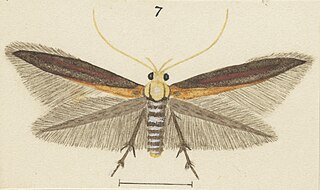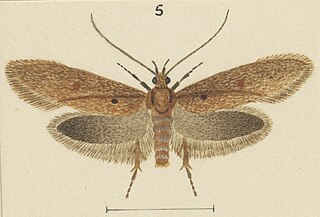
Sagephora is a genus of moths belonging to the family Tineidae.

Izatha mesoschista is a moth of the family Oecophoridae. It is endemic to New Zealand.

Izatha caustopa is a lichen tuft moth in the family Oecophoridae. It is endemic to New Zealand, where it is known very locally, and very infrequently, from the southern half of the North Island: two specimens collected in 2016 were the first seen for 30 years. It is classified as "Data Deficient" by the Department of Conservation.
Petasactis is a genus of moths belonging to the family Tineidae. It contains only one species, Petasactis technica, which is endemic to New Zealand. This species has not been collected since prior to 1888. It is classified as "Data Deficient" by the Department of Conservation.

Pasiphila cotinaea is a species of moth in the family Geometridae. It is endemic to New Zealand. Its larvae feed off Olearia species and the adult moth can be seen on the wing from November to April. This species is regarded as rare.

Stathmopoda endotherma is a species of moth in the family Stathmopodidae. It is endemic to New Zealand. It is classified as "At Risk, Naturally Uncommon" by the Department of Conservation.

Eudonia ustiramis is a species of moth in the family Crambidae. This species is endemic to New Zealand. It is classified as "Data Deficient" by the Department of Conservation.

Donacostola notabilis is a species of moth in the family Xyloryctidae, and the only species in the genus Donacostola. The species was described by Alfred Philpott in 1928; the genus established by Edward Meyrick in 1931. The species is endemic to New Zealand.

Monopis ornithias is a species of moth in the family Tineidae. It was described by Edward Meyrick in 1888. This species is endemic to New Zealand.
Monopis typhlopa is a species of moth in the family Tineidae. It was described by Edward Meyrick in 1925. This species is endemic to New Zealand.

Proterodesma byrsopola is a species of moth in the family Tineidae. It was described by Edward Meyrick in 1909. This species is endemic to New Zealand.

Prothinodes grammocosma is a species of moth in the family Tineidae. It was described by Edward Meyrick in 1888. This species is endemic to New Zealand.

Sagephora exsanguis is a species of moth in the family Tineidae. It was described by Alfred Philpott in 1918. This species is endemic to New Zealand and has been found on Cuvier Island, as well as the North and South Islands. The adults of this species are on the wing from October to December.

Sagephora phortegella is a species of moth in the family Tineidae. It was described by Edward Meyrick in 1888. This species is endemic to New Zealand.

Sagephora steropastis is a species of moth in the family Tineidae. It was described by Edward Meyrick in 1891. This species is endemic to New Zealand.

Tinea belonota is a species of moth in the family Tineidae. It is endemic to New Zealand. It is classified as not threatened by the Department of Conservation.

Scythris niphozela is a species of moth in the family Scythrididae. It is endemic to New Zealand. It is regarded as endemic to the Kaitorete Spit area although it had been recorded in the Manorburn Ecological District. This species inhabits the foredune area of Kaitorete Spit. The larvae feed on Carmichaelia appressa. Adults day fly from October to December. These moths are not attracted to light. The species is classified as "At Risk, Naturally Uncommon" by the New Zealand Department of Conservation.

Leptocroca xyrias is a species of moth in the family Oecophoridae. The taxonomy of this species is in need of revision and L. xyrias likely belongs to a separate genus. It is endemic to New Zealand. It has been classified as Data Deficient by the Department of Conservation.

Tingena is a genus of the concealer moth family (Oecophoridae). This genus is endemic to New Zealand.

Scythris epistrota is a species of moth in the family Scythrididae first described by Edward Meyrick in 1889. It is endemic to New Zealand and has been observed in the South Island. The larvae have been found on species of New Zealand broom and they pupate within an irregularly shaped, dense, silken cocoon. Adults are day flying and are on the wing from November until February.

















